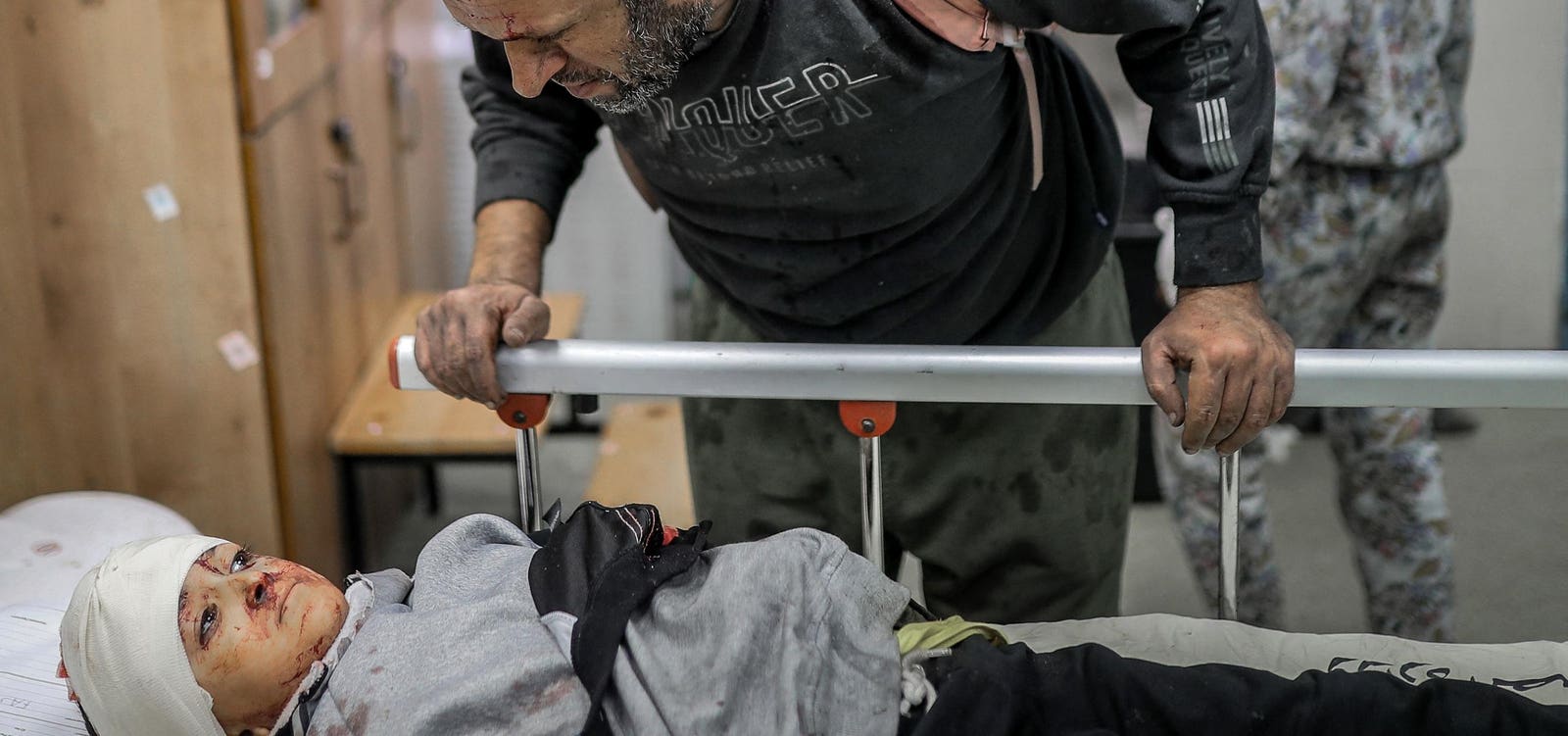Share to Facebook
Share to Twitter
Share to Linkedin
TOPSHOT – An injured Palestinian man looks at an injured child lying on a gurney at the hospital … [+] following the Israeli bombardment of Khan Yunis in the southern Gaza Strip on November 15, 2023, amid the ongoing battles between Israel and the Palestinian group Hamas. More than 11,000 people have been killed in relentless Israeli bombardment of the Gaza Strip, according to the Hamas-run health ministry, since the war erupted after Palestinian militants raided southern Israel on October 7 killing at least 1200 people, according to official Israeli figures. (Photo by Belal KHALED / AFP) (Photo by BELAL KHALED/AFP via Getty Images)
AFP via Getty Images
The New York Times recently published a poignant opinion essay titled “What Doctors and Health Care Workers in Gaza Saw,” which included firsthand accounts from medical personnel on the ground, as well as photographs of X-rays depicting children shot in the head and heart.
These photos are more than just images. They shape how readers around the world perceive the conflict. Yet, in today’s media landscape, where trust in traditional journalism is often tenuous, news outlets face the added challenge of convincing audiences to believe these images are real.
In a world where altered images and AI-generated media circulate freely, the authenticity of news media content is constantly scrutinized. For media organizations like the New York Times, verifying the images they publish isn’t merely a technical concern; it’s essential to maintaining the credibility of the content they are conveying, be it breaking news or an opinion essay.
In cases like this, where emotionally charged visuals accompany stories of immense human suffering, authenticity is vital for two key reasons.
First, verified images enhance the publication’s ability to share meaningful news and influence public understanding.
MORE FOR YOU
New Gmail Security Alert For 2.5 Billion Users As AI Hack Confirmed
Comet Tracker For Sunday: When And Where To See It Tonight
Updated Northern Lights Forecast: Here’s Where You May Be Able To See Aurora Borealis Tonight
Second, image authentication helps counter growing cynicism and conspiratorial thinking among readers who are increasingly skeptical about the reality behind what they see.
Fakes Everywhere: What’s a Media Organization To Do?
News outlets could adopt more rigorous authentication practices for the visuals they publish. In doing so, they protect their reputations, build trust with their audiences, and help cultivate a more informed, less cynical readership.
The modern media audience is more skeptical than ever. In recent years, conspiracy theories and cynicism have grown as readers encounter increasing reports of deepfakes, AI-generated content, and altered images.
Many viewers now approach images with suspicion, wondering if they’re seeing the truth or merely a manufactured version of it. This shift has significant implications for news outlets, as the trust between media organizations and their audiences has been steadily eroded by the proliferation of fake and misleading visuals.
For readers, the presence of authentication data can make all the difference in their willingness to trust an image and the story it represents. Authentication practices, such as providing metadata, verifying the chain of custody, and using forensic analysis help assure readers that the images they’re viewing are accurate and genuine.
By sharing some of these verification details with the public, news outlets can foster a more transparent relationship with their audiences, addressing potential doubts before they arise.
In a highly charged political climate, images from conflict zones often face intense scrutiny and even accusations of fabrication. By incorporating authentication data into and with these images, such as timestamps, location data, and verification of the source, news outlets can preemptively counter claims of deception.
This transparency can alleviate concerns among readers who might otherwise assume the worst, thereby promoting a more informed and less conspiratorial audience.
What If Image Authenticity Cannot Be Proven?
I have qualified and testified in court as an expert in video, photo, and audio forensics. Often my work involves examining media to determine if it is authentic, fake, or been subject to tampering or manipulation.
Sometimes I cannot determine conclusively one way or the other, but I can explain the reasons why and give an expert opinion on if I believe the photo to be real or fake.
Even if authenticity cannot be proven conclusively, showing the evidence either way concerning authenticity includes the reader in the decision process, much like an attorney lays out evidence but the final decision is left to a jury.
If a media organization believes a story or image could be especially inflammatory, it would be wise to preempt the attacks on the authenticity of the image by having a forensic analysis performed and the expert’s opinion included with the image.
The Case for Setting Standards in Media Image Authentication
The case for pairing images with verification data is clear. Perhaps it is time for media organizations to go on the offense when it comes to image authentication instead of reacting and defending when the flood of fraud accusations come pouring in..
To ensure credibility, sensitive images, particularly those with political or humanitarian implications, could come with standards that enhance their reliability.
For example, when presenting images of conflict zones, media outlets could adopt a best practice of publishing metadata, chain of custody, and digital analysis results alongside the visual content. This would not only increase transparency but also help the public make more informed decisions based on verifiable information.
Other fields already require similar standards. In scientific research, for instance, data must be carefully documented and verified before it is published. Legal evidence undergoes rigorous authentication to establish its credibility in court.
By having similar standards for images, particularly those with high public impact, we can ensure that digital media is both transparent and trustworthy. In the case of politically sensitive content, like the images from Gaza, this shift could transform how media is consumed and interpreted by the public.
The Benefits Go Both Ways
Adopting image authentication standards benefits both news organizations and the readers they serve. For news outlets, these standards protect their reputations and reduce the likelihood of inadvertently publishing misleading or fake content.
By committing to rigorous verification, news media can ensure that their reporting is both accurate and impactful. By then sharing that information, they foster an environment where truth is valued and public discourse is informed by reality.
For readers, authentication provides clarity and reassurance. When news outlets publish authenticated images, they invite readers to trust not only the visuals but also the stories and information accompanying them.
This practice helps counter the growing tendency toward conspiratorial thinking, allowing audiences to feel more confident in the media they consume. By reducing the sense of skepticism and doubt, news outlets can promote a healthier, more transparent media landscape where readers are less likely to fall prey to misinformation.
A Return To “Trust, But Verify”
There was a time when people believed until given a reason not to, but not today. Many operate from a frame of disbelief and cynicism, and not entirely without reason.
While I doubt we will, or should, return to a time of blind trust in the media, I do believe we can return to a form of “trust, but verify.”
If the original version was to believe until given evidence to the contrary, the 2.0 version is the same, but flipped. Now verification must come first before the seeds of trust can take root.
It Makes Business Sense, Too
The New York Times article on Gaza serves as a timely reminder of the importance of authenticity in visual media. As technology continues to advance, the lines between real and fabricated images blur, leaving readers to question what they can trust.
By committing to verification standards and embracing transparency, news outlets can help build a media landscape that is both credible and resilient. In this way, they not only share meaningful news but also contribute to a more informed, less cynical world.
Further, adopting robust authentication practices offers a chance to strengthen their credibility, protect their reputations, and distinguish themselves as trustworthy sources of information.
For readers, these practices provide a much-needed foundation of trust, allowing audiences to believe in the visuals they see and the stories they read.
Proactively providing evidence that we can trust what we see is good for readers, and a balm to the reputation of media organizations. In business, Trust is usually good for the bottom line as well.
Note: I wrote this article not to question the integrity of news outlets but rather to highlight a crucial aspect of today’s digital media landscape: images alone are no longer enough to establish authenticity.
Follow me on LinkedIn. Check out my website.
Lars Daniel
Editorial Standards
Forbes Accolades





